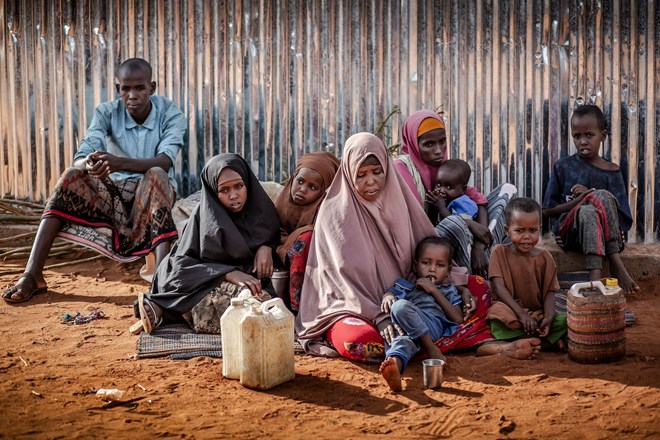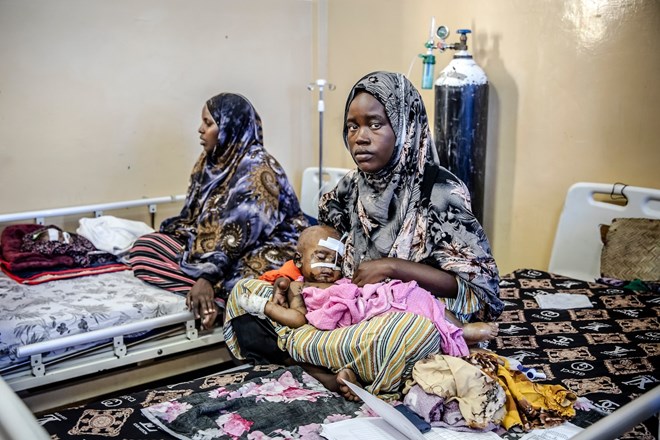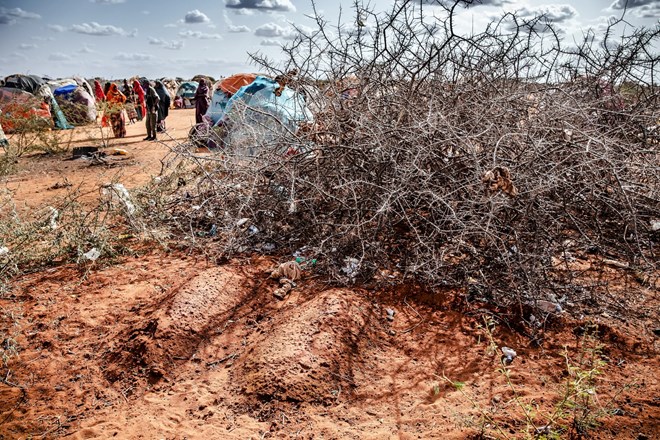
Friday July 1, 2022
By Sudarsan Raghavan
Photos by Luis Tato
More than 7 million Somalis face acute food insecurity, with almost 250,000 at risk of imminent starvation

Hodan Mohamed Sirad, center, sits with her children and other relatives as they wait on June 15 to be settled at the Kahareey aid camp near Dolow, Somalia.
DOLOW, Somalia — On the second day fleeing drought and hunger, 5-year-old Amina Abdi could no longer walk. She hadn’t eaten in a week. Her tiny body was skeletal; her skin was flaking from severe malnutrition. She collapsed on the orange desert sand and lay motionless in the heat.
Her mother shook her body. She searched for a heartbeat.
“She was soon not moving anymore,” recalled Hodan Mohamed Sirad, her voice fading into silence.
Amina is just one among hundreds of children who have died of hunger in recent weeks, casualties of the worst drought in four decades and a confluence of crises that again have put Somalia on the brink of famine. There are the familiar culprits: a dearth of rainfall made worse by climate change; conflict; disease; the coronavirus pandemic; and even locust infestations.
But unlike previous hunger calamities, this one is exacerbated by a conflict 3,000 miles away. Russia’s invasion of Ukraine is fueling starvation in Somalia and other nations, abetting death, sickness, the disintegration of families and the loss of livelihoods far from the war’s front lines.
Before the invasion, Ukraine and Russia were among the world’s top producers and exporters of grains, cooking oil and fertilizers, and together provided nearly all of Somalia’s wheat. The disruption of crude oil from Russia has led to soaring costs for fuel, transportation and food production. Food prices, already at record levels here because of drought and the pandemic, have climbed ever higher as Russia continues to block Ukraine’s primary export route through the Black Sea.
“The crisis is worse now than anytime in my lifetime working in Somalia for the last 20 years, and it is because of the compounded effect of the war in Ukraine,” said Mohamud Mohamed Hassan, Somalia country director for the charity Save the Children. “Communities are at a breaking point.”
Last month, Russia’s Defense Ministry offered to grant passage to ships carrying Ukrainian grain and other goods — but not until Western sanctions are lifted. Russia’s blockade has been declared a “war crime” by the European Union’s top foreign policy official: “You cannot use the hunger of people as a weapon of war,” implored Josep Borrell last week at a meeting of E.U. ministers in Luxembourg.
More than 18.4 million people in Somalia, Ethiopia and Kenya are now facing acute food insecurity, according to the United Nations. About 7.1 million of them are Somalis — nearly half the nation’s population — with almost 250,000 at risk of imminent starvation. Many communities haven’t fully recovered from the last drought, in 2017, or the last famine, in 2011.
In the first quarter of this year, more than half a million Somalis fled their homes in search of food, an outflow of desperation that is steadily rising each day.

Mana Abdullahi Aden, 28, holds her severely malnourished 17-month-old, Munasar Ali, at Banadir Hospital in Mogadishu, the Somali capital.
Somalia’s children are the most vulnerable. The U.N. Children’s Fund (UNICEF) says 1.4 million younger than 5 face acute malnutrition. U.N. data shows 448 deaths of children in malnutrition treatment centers from January to April.
Yet the true number is much higher, U.N. workers said, because many deaths go uncounted. Children are dying in their homes — in villages where aid workers fear to go — from hunger and related illnesses such as measles and cholera. They are often buried in unmarked graves in the desert or in camps for the displaced.
Over three days spent between the camps of southern Somalia and the severe malnutrition ward of a hospital in the capital, Mogadishu, Washington Post journalists visited the graves of six children and learned of the passing of 11 others through interviews with displaced Somalis. None of the deaths had been reported to local authorities.
A deadly journey
Sirad carried her daughter’s body to a nearby village. A few women washed and covered it in a white cloth, in accordance with Islamic tradition. An elder recited a Quranic prayer before Amina was lowered into the ground.
“I was crying,” Sirad said. “I watched from a distance.”
Afterward, she tucked away the faded purple dress the girl had last worn into a white burlap bag filled with her family’s meager possessions. Then she started to walk again.
The 40-year-old mother still had six other children to save.
Two days later, her family reached Dolow, a drab border town edged against Ethiopia that is a magnet for tens of thousands of people seeking assistance from the Western and local aid agencies based here. But the long shadow cast by the war in Ukraine now means less help to go around, U.N. and Somali aid officials said.
Of the $1.5 billion the United Nations says is needed to help the most vulnerable in this country, donors have provided only 18 percent. Somalia is competing with other nations hobbled by the rapidly spreading global food crisis, and it is losing.
“Geopolitical tensions always define the international priorities,” said Abdirahman Abdishakur Warsame, the nation’s special presidential envoy for drought response. “Ukraine has taken away the attention of the international community, particularly Western donors. The majority are not paying attention to the Somali crisis.”
The United States is Somalia’s largest donor by far. When asked about the shortfalls in assistance, U.S. Ambassador Larry André said Washington had recently increased aid to the region by $105 million. U.N. and Somali officials say far more is needed. By comparison, the U.S. Congress last month approved $7.5 billion in economic aid to Ukraine.
The scant donor funds the United Nations and other aid agencies receive are stretched increasingly thin: Rising prices for food, fuel and transportation, by both air and sea, have driven up the cost of therapeutics and other commodities purchased by the U.N. World Food Program to alleviate hunger and prevent children from dying. The organization, which depended on Ukraine for more than half its wheat supply, has been forced to slash food rations for the most at-risk populations in East Africa and the Middle East.
“We have all the mechanisms in place, but no resources,” said Ezana Kassa, Somalia head of program for the U.N. Food and Agriculture Organization. “We have a vehicle without fuel. It’s quite difficult to do anything.”
The day after Sirad and her remaining children reached the camp, a new group of families emerged from the desert, clutching empty yellow water cans and white sacks once used to hold grain, now stuffed with whatever belongings they could carry. They were farmers and herders from villages near the provincial capital, roughly 40 miles away. Their journey had taken four days.
Some walked slowly, weakened by hunger; some of the elderly were limping. Those on donkey carts were careful not to push the animals too fast, lest they perish in the heat. They had passed the rotting carcasses of goats, donkeys and a camel.
“We buried three children along the way,” said Abdi Mohamed, 60, a frail farmer who was leading the group of 56 families. Two babies, both a year old, died on the same day. A 2-year-old died the next day.
The last time they experienced such devastation was during the 2011 famine. “It’s worse this time,” said Mohamed, echoing what virtually every Somali told The Post.
In 2011, the villagers endured two failed rainy seasons, but some of their livestock survived. They sold the animals to buy food, which they could still afford. Now, the rains have failed them for four consecutive seasons, food is more expensive, and the climate has become hotter and more volatile. “Those extreme climate situations have been on the increase in past years in a way that communities are not recovering,” said Kassa, of the Food and Agriculture Organization.
Over the past year, the families’ plight grew more desperate. They went through their savings and started selling off their livestock. Then the cattle, goats and camels began dying, among the 3 million animals the United Nations says have perished in Somalia since mid-2021. Their relatives abroad, part of a vast Somali diaspora, lost work during the pandemic and couldn’t send money as they had done during previous crises. Wells and boreholes dried up. Once-reliable clan and family support networks crumbled.
“We lost everything. We had no choice but to walk here,” said Halima Ahmed, 40, standing next to Mohamed.
Sirad and her family couldn’t grow sorghum for two years on their farm. After finishing the grain they had stored away, they had few options. “We didn’t eat for five days,” her son Abshur Abdi, 17, recounted. “We were drinking only water. So we left.”
In Dolow, they joined several generations of their countrymen displaced by drought, famine and violence. Thousands who fled in 2011 and 2017 remain in two large camps here, dependent on aid. Between 100 and 150 families are arriving each day to newly formed camps, adding to the pressure on the town and aid agencies, said Mohamed Hussein Abdi, the district commissioner. “We are lacking land to settle those people.”
Hundreds of thousands of Somalis remain in villages, trapped by conflict and geography. Many rural areas are controlled by al-Shabab, the shadowy Islamist militant group that has fought the government and its Western backers for more than a decade.
What little food is grown in those areas is heavily taxed by the militants, according to people fleeing. Aid agencies consider it too risky to access communities controlled by al-Shabab, fearing attacks or kidnappings.
Some families who escape are forced to make a terrible choice. “I left five of my children behind,” said Halima Hussein, 31, who arrived with the three who could walk. The rest, too weak from hunger to survive the journey, remain in the village with relatives. “I couldn’t carry all of them,” Hussein said.
Children are ‘buried everywhere’
By the time Farheiya Ibrahim arrived at the Waafi camp for internally displaced people on the fringes of Mogadishu, it was too late for two of her seven children. The camp is 300 miles east of the one in Dolow but has the same problems — it is overcrowded, with little access to clean water or sanitation. Both children had caught measles. Soon they had intense diarrhea and began vomiting. There was no health clinic nearby.
Ahmed, 3, his feet swollen by malnutrition, died first. A week later, his older sister Najma followed. She was 7.
“She went through the same pain her brother went through,” said Ibrahim, 39, with a blank stare. “One night, she vomited something green and died.”
Her neighbors in the camp buried the siblings side-by-side. There was no service because “nobody knew them,” Ibrahim said. She hasn’t visited their graves, which are only 50 feet from her makeshift hut and are now covered with trash — a piece of corrugated iron and a child’s brown shoe.
“If I see where they are buried, I will cry,” she said, tears welling in her eyes.
Maka Ali, the 70-year-old deputy leader of the camp, said visits by aid agencies are infrequent. “People don’t have enough food,” she said. “Most of the children are malnourished.”
Across the country in the camps of Dolow, similar cases abound. Habiba Mahmoud walked 47 miles while nine months pregnant and went days without eating. When she finally arrived, she gave birth to twins — a girl and a boy. Both died soon afterward. Their graves are outside her hut.
Nima al Barre was so weak from hunger that she couldn’t breastfeed her 9-month-old twin girls, Ebla and Abdiya. Sugar and water weren’t enough to keep them alive. Their graves are here, too.

The graves of Habiba Mahmoud’s twins, a boy and a girl, are not far from her shelter.
“Those who are under 5 are buried everywhere,” said Hussein Aden Barre, a camp elder.
At a feeding center for severely malnourished children, a steady stream of mothers and babies arrived.
The children had the diameter of their arms measured and then were placed in a bucket to be weighed. Most were underweight.
On one day this month, the center had only a week’s worth of UNICEF-distributed therapeutic food packets left.
“The support from UNICEF is not enough,” said Abduqani Mohamed, the nutrition officer for SEDA, a local aid organization that runs the facility. “All the efforts are focused elsewhere, especially on Ukraine. No one is giving priority to Somalia.”
Victor Chinyama, a UNICEF spokesman, acknowledged serious shortfalls in international assistance in camps in Dolow and elsewhere. “When the [U.N.] appeal is not fully funded, this is what you have on the ground. The needs are huge, but the funding to address those needs is not adequate.”
Like other charities, the World Food Program distributes $75 vouchers for the most vulnerable households to purchase food in the markets from designated vendors. But voucher holders are getting less food with the same amount of money. A kilo (2.2 pounds) of potatoes in Dolow cost 50 cents in March; now it’s $1. Cooking oil has gone from $5 a liter (about a quarter of a gallon) to $13 a liter. Therapeutic food packets have shot up from $40 a carton to $47 in recent months.
The story is the same in Mogadishu, where the cost of a 400-gram (14-ounce) can of wheat has doubled since February. Prices for other grains, vegetables and fruits have skyrocketed as well. “After the Ukraine war began, everything shot up in price,” storekeeper Hirsi Mohamed said.
“Many people would have survived if the Ukrainian crisis was not there and food was coming in,” said Hassan, the country director of Save the Children. “At least food prices would have been stable, and food would have been available.”
If purchasing power keeps declining and humanitarian relief doesn’t reach the most vulnerable, Somalia could experience a famine in the months ahead. Already, U.N. agencies are projecting that a fifth rainy season could fail in late 2022.
The previous famine killed an estimated quarter-million people, half of them younger than 5. Today, UNICEF estimates that 386,000 children are at risk of death without immediate treatment for severe acute malnutrition, already surpassing the 340,000 children who needed treatment in 2011.
“Unless there is an early and stepped-up further response, the risks are this could worsen to catastrophic levels later in the year,” said James Swan, the U.N. secretary general’s special representative for Somalia.
At the camp in Dolow, Sirad and her children had eaten only two small meals in three days, food provided by sympathetic neighbors. They were still sleeping on the ground, waiting for camp elders to erect a makeshift tent that would become their home. With no sense of what the future might bring, Sirad remains gripped by the past.
“When I sleep at night, I still dream about Amina,” she said. “I feel she is around me.”
Last week, she pulled Amina’s purple dress from the burlap bag. Her 3-year-old daughter, Nimo, who looks smaller than her years, playfully tugged at the dress. Sirad allowed herself a moment of hope.
“When Nimo reaches Amina’s age, I will give this to her,” she said, smiling faintly.